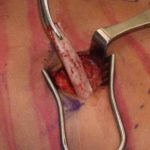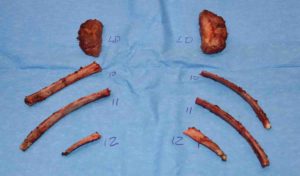Rib removals for waistline narrowing is the final step for maximal waistline narrowing. After weight loss, exercise and liposuction the final anatomic ‘obstruction’ remains that of the lower ribs for optimal. What differentiates the lower or free floating ribs from those above it is that they are bony appendages with terminal ends. They do not connected to any ribs above it and, as a result, have a different angulation. Rather than having a more horizontal orientation, they point much more downward. (this is in contrast to many anatomic depictions which show them to be more horizontal in orientation)
The lower two ribs (11 and 12) are known as the free floating ribs because they do not connect to any other ribs and only have a proximal attachment to the spine. The remaining ten pairs of ribs above connect, directly or indirectly, to the sternum. Without a connection this allows the ribs to angle more downward or ‘float’. The reality is that the floating ribs do have firm soft tissue connections at their cartilaginous tips to the abdominal musculature. Thus when the floating ribs are removed the waistline collapses inward due to loss of both structural bony support and their muscular attachments.


Dr. Barry Eppley
Indianapolis, Indiana



